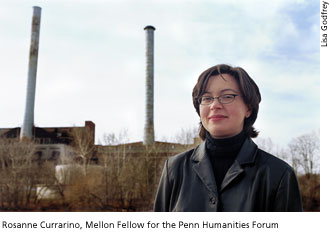
The Look of History
Hours of Work and the Consumer Citizen

Rosanne Currarino, one of this year’s Mellon Postdoctoral Fellows
with the Penn Humanities Forum, spent the past academic year stuffed into
a tiny office on the second floor of 3619 Locust Walk. Her window has
a view into the window of a building across the alley. "I’ve
been watching that guy watching me watching him," she quips.
As a Mellon Fellow, she spent the year looking into the meaning of time for wage earners in the "Gilded Age" as America fell headlong into the full embrace of industrial capitalism. The research provided raw material for two undergraduate history courses: Work and Leisure in the fall and Industrial Time in Nineteenth Century America in the spring.
A high-school history teacher ignited in Currarino a fascination with historiography, the storytelling that shapes a coherent chronicle out of historical data. "Oh, wait, it’s not just about the facts," she remembers thinking as the fire kindled. It all depends on how you look at the records and dates and facts and figures.
 Currarino
looks at intellectual history, the concepts that people used to understand
what was happening in their world, and the ideas and arguments they offered
to justify change. This year she has turned her gaze upon the views of
post-Civil War economic theorists, social reformers, and labor organizers.
"Late 19th century social movements to shorten the hours of labor
in America were quite literally about time," she contends, "specifically
about the amount of time an employer could require an industrial wage
laborer to work."
Currarino
looks at intellectual history, the concepts that people used to understand
what was happening in their world, and the ideas and arguments they offered
to justify change. This year she has turned her gaze upon the views of
post-Civil War economic theorists, social reformers, and labor organizers.
"Late 19th century social movements to shorten the hours of labor
in America were quite literally about time," she contends, "specifically
about the amount of time an employer could require an industrial wage
laborer to work."
The Industrial Revolution was already far along in transforming England when it crossed the Atlantic with the colonists. In the New World, it pushed aside the established agricultural and small-craft social order and started building up a new one, powered by industry and mass production. Where artisans and farmers once controlled their own time in plying their craft, factory workers had to punch a time clock, rendering them, in effect, "wage slaves." By the late 19th century, America was threatened by a second civil war, this time between angry workers and the police, who enforced a social order that favored wealthy industrialists.
The view of classical economics, held by many factory owners, was that profits could be kept high by keeping the cost of labor low—more hours for less pay. "But there were some capitalists," Currarino points out, "who began to see a better way: ‘Well, no,’ they argued. ‘If we make almost no profit but sell millions of these things, we’ll still do very nicely.’" Labor activists too began to modify their outlook, urging that shorter hours, at the same pay, would give workers leisure time as well as discretionary income, which they could use to buy all those new things.
"That shift is really crucial," she reasons, "because it means that work production is no longer the only or most important contributor in how you form a new identity or create a kind of power for yourself in society. Time away from work is more important."
Under this outlook, independence was no longer the privilege of property owners but the right of anyone who had "free" time. "By stressing workers’ social role as consumers rather than producers," Currarino suggests, "labor intellectuals constructed new rights of citizenship, including the right to employment, high wages, and leisure time, which complemented and bolstered workers’ social roles as consumers."
The reformers’ vision changed more than the definition of who workers are: it altered facts. How you look at the world can determine—or at least change over time—what you see. We sometimes call it "making history."